When the topic of agricultural pest management is mentioned, most people think first about monitoring for pests or intervening to reduce pests: scouting, pest identification, and/or application of pesticides are some specific practices. However, prevention is an often-overlooked key strategy that farmers can use to minimize the likelihood of pest problems. This article will explore the role of prevention in a pest management plan.
Introduction
What is a pest?
An agricultural pest is any organism or infectious agent that causes stress or damage to a desired plant or plant product. For example, a weed is a pest if it competes with a crop for resources, causing the crop stress it otherwise would not have. Infectious bacteria, fungi, and viruses cause diseases and are therefore pests. These small pests are transferred from one plant to another through water, through the air, by insects, or by larger animals (including humans). The most familiar pests are insects, ranging in size from the small whitefly to large swarms of locusts. Larger pests such as birds, mice, and rabbits can also cause damage in the field.
Some pests affect agricultural products in storage, such as cereal and pulse grains (Sallam, 1999; Manandhar et al., 2018). However, this article will focus on preventive pest management in the field. In the remainder of this article, the term ‘pest’ will refer only to agricultural pests that affect crops in the field.
A brief history of pesticides
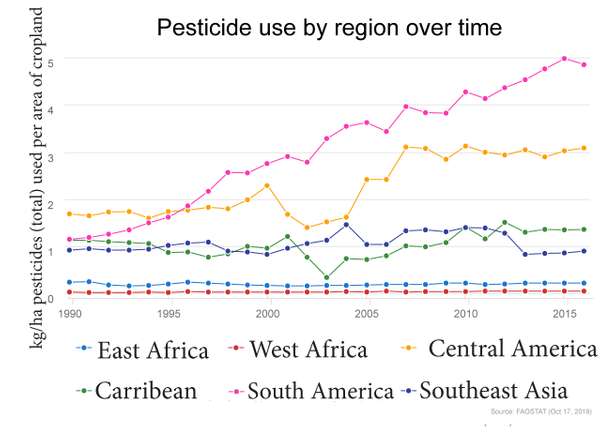
Figure 1. Total pesticide use by region of the tropics over time. Source: FAOSTAT 2019
Throughout history and across cultures, farmers have used a variety of resources, strategies, and practices to manage in-field insect pressures. Naturally-derived compounds (e.g. sulfur) have been used as pesticides for thousands of years. By contrast, synthetic pesticides have only been produced and used since the 1940s.
Trends in the Global North: The combination of the Industrial Revolution and the Green Revolution in the Global North allowed for the relatively rapid spread and broad use of synthetic pesticides without consideration for human or environmental health. Concerns associated with pesticide use emerged in the 1960s, leading to the establishment of protection agencies. Now, pesticides are largely controlled by governmental regulations that vary among countries, but that generally aim to protect farm workers, pesticide handlers, and the environment.
Trends in the Global South: In the Global South, the access, use, and regulation of synthetic pesticides has varied over time and among regions. Figure 1 illustrates some recent trends in pesticide use by region. Pesticide use in South and Central America has increased over the past three decades, while other regions of the tropics have remained roughly the same (FAOSTAT, 2019; Schreinemachers and Tipraqsa, 2012). Up to 25% of countries in the Global South lack pesticide regulations and (where such regulations exist) their enforcement. This is due to insufficient resources, lack of incentives for enforcement, limited environmental standards, and lack of cohesion between relevant departments (Phung et al., 2012; Schreinemachers and Tipraqsa, 2012; Kegode, 2019). Often farmers are not sufficiently educated about how to properly mix and handle pesticides, dispose of pesticide containers, and use personal protection equipment. In an effort to unify international standards of pesticide management and to reduce some of the negative effects of regulatory gaps, the FAO and WHO jointly released The International Code of Conduct on Pesticide Management.
Concerns in pest management
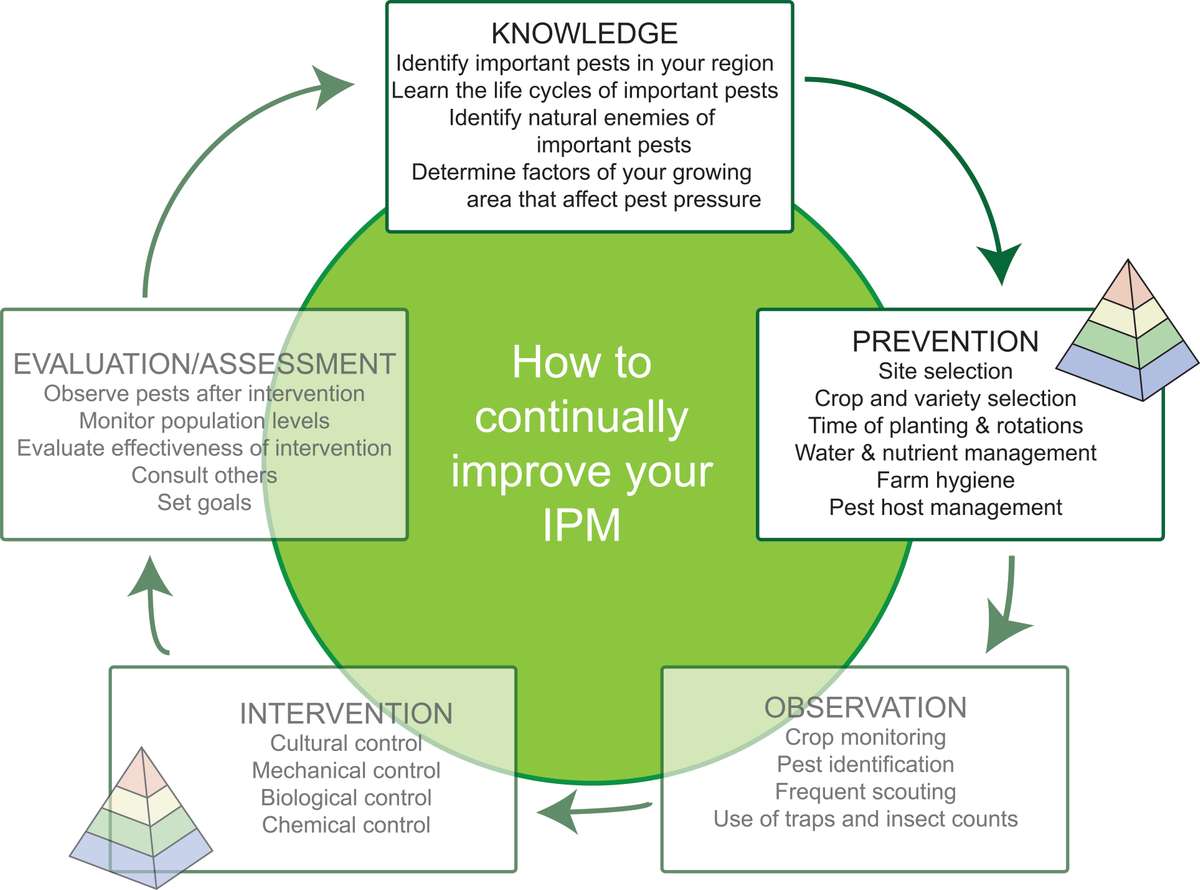
Figure 2. Stages of an example IPM cycle. Planning can start at any stage of the cycle, and the order of stages is flexible. The pyramid icon indicates stages that include strategies that prevent or suppress insect pests. Some “Prevention” stage strategies are described in this article and are illustrated in figure 5. Source: Adapted from farmbiosecurity, Creative Commons Attribution 3.0 license
Pesticides have become a vital part of sustained food production to meet the needs of a growing global population. However, widespread pesticide use poses concerns to human health, the environment, and long-term sustainability. As an example, the process of pests becoming resistant to pesticides reduces the long-term effectiveness of those pesticides.
Climate change, the introduction of new pests, and several other factors have increased pest pressures in the tropics, where food insecurity is already a major concern. Pests contribute greatly to crop loss, and farmers in resource-limited regions experience some of the most significant effects (Chakraborty and Newton, 2011). For example, over the past three years in East Africa, the combined drought and fall armyworm infestation resulted in maize crop losses of up to 100% for some farmers (FAO, 2017; Sisay et al., 2019).
The current global situation calls for a multi-pronged approach to pest management. To be widely applicable, this approach must provide farmers with options to control pests at various scales of production (from small farms to very large operations) with a diversity of resources. Integrated pest management (IPM), a strategy based on farmer innovations, is highly adaptable to specific contexts and reduces dependency on pesticides while still recognizing their use. IPM has gained traction since 1989; in particular, Farmer Field Schools (FFS) have effectively educated farmers about IPM (Peshin et al., 2009).
IPM focuses on the larger system and aims for long-term prevention of pests using a combination of techniques and controls. An individual farmer’s IPM plan should constantly improve as it cycles, as shown in figure 2. The rest of this article will address the knowledge and prevention aspects of the cycle.
Knowledge
Learning is useful at any time in a continually improving IPM strategy, but can be especially advantageous when beginning an IPM plan. Obtaining some of the important information may require community collaboration.
Identify important pests in the region
Seasonal insect pressure can change from year to year, due to the introduction of new pests from global trade and/or from the abiotic spread of pests and disease. Still, it is important to record pests that farmers regularly see during different growing seasons; this will help you understand which pests are common, and when they tend to arrive each season.

Figure 3. Cowpea bruchid (Callasobruchus maculatus) eggs (left) and adults (right). On the cowpea seed, you can also see a hole where one of the larva emerged. Source: Tim Motis
Learn the life cycles of important pests
Pests’ lifespans and life cycles vary greatly. You should be able to identify common pests in many different life stages, such as egg, larva, nymph, pupa, or adult (Figure 3). If you can recognize stages in pests’ life cycles, you will be better able to intervene, because some interventions are only effective at certain life stages. Information such as lifespan and/or the presence of a winged stage allows you to estimate the potential rate of spread and/or mobility of the pest population.
Identify natural enemies of important pests
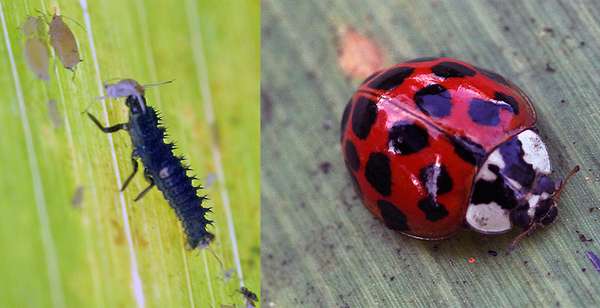
Figure 4. Ladybug (Harmonia sp.), an insect pest predator. The larva in the left photo is feeding on aphids. The right photo shows an adult ladybug. Both were on sorghum leaves at ECHO in Florida. Source: Tim Motis
Natural enemies of pests may live in the environment and already help control the pest population naturally. Some natural enemies are well-known (Figure 4), while others can be determined by carefully observing interactions between pests and other species. Once you know of natural enemies, you can record their relative abundance before and during the growing season.
Determine factors in the growing area that affect pest pressure
Pay attention to factors in the growing area that affect pest pressure. These may be environmental, such as trends observed in the field during and after the growing season. They may also include cultural, economic, political, and social dynamics. Here are some examples of questions to think about and discuss at a community level:
- Does everyone plant at the same time? Some pests only affect crops during specific windows of plant development. If all farmers in a region plant a crop at the same time, hypothetically they will all experience similar pest pressure. However, if one farmer’s crop is behind everyone else’s, that farmer may experience significantly more pest pressure.
- Is it socially and culturally acceptable to apply pesticides in the region? If the government restricts use of certain pesticides, farmers should follow regulations and guidelines set by local authorities. If certain pesticide applications are somehow socially unacceptable, farmers should make sure that the community is aware of their IPM plan so that the community can respond in whatever way they feel most comfortable. For example, if a farmer is applying pesticides on crops next to a school, the community may express that this should be done when students are not in school for a certain amount of time. The community may also ask the farmer to put up a hedgerow between his field and the school. Does the community have expressed goals for pest management?
- What management options are feasible, given the available resources? List pest management techniques that are currently used, and record their efficacy (recognizing that this will probably be subjective). What quantities of time, resources, and effort are currently invested in pest management? A lack of resources may limit the number of sustainable and feasible pest management techniques.
Knowledge is an important piece of an IPM strategy. It empowers farmers by increasing awareness of pest traits and helping to shift farmers’ mindsets, so that they proactively focus on prevention of pest problems rather than reactively waiting to see and treat problems that might arrive.
Prevention
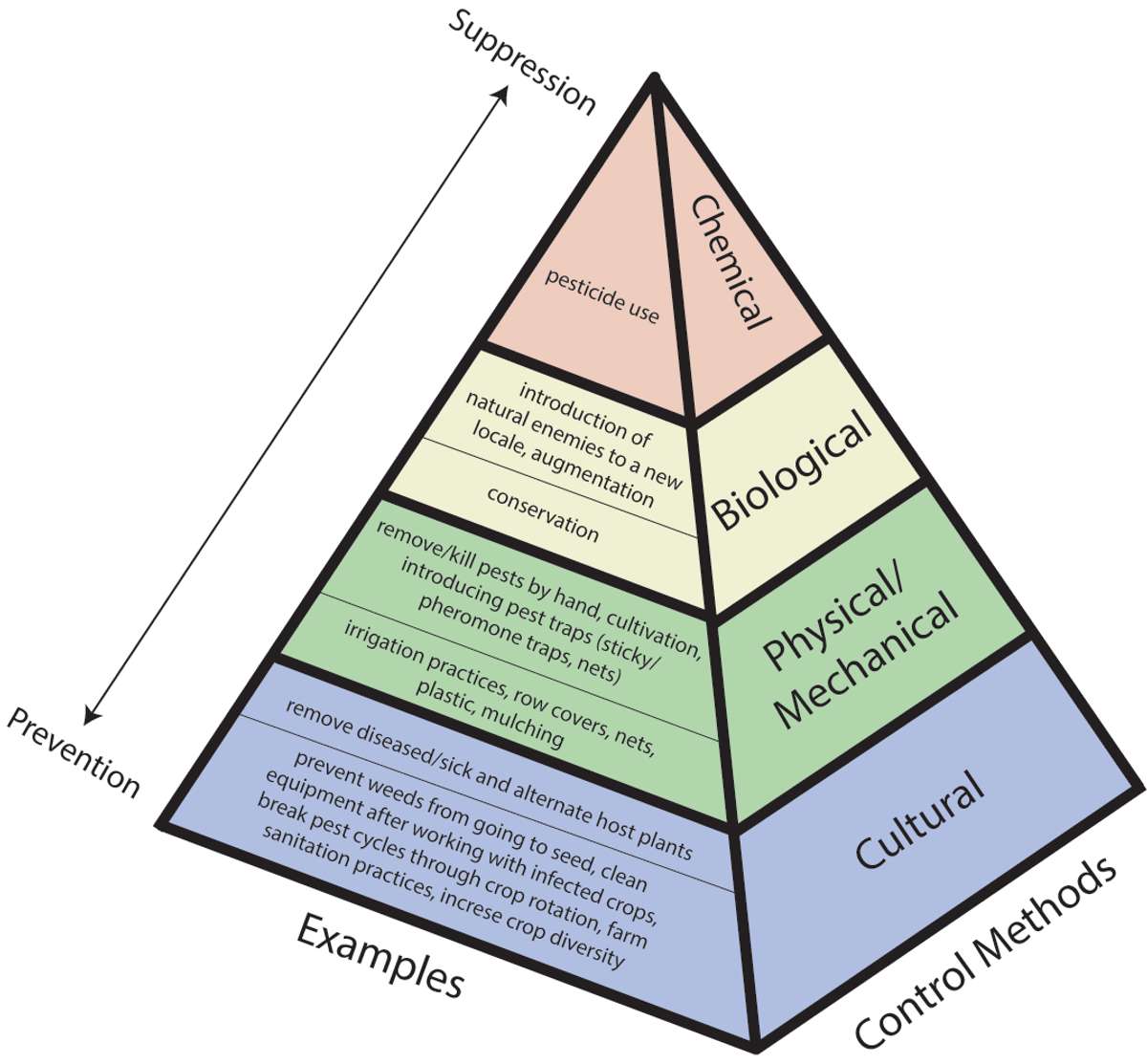
Figure 5. Control method categories and examples. Examples that are preventative techniques are in the base of each box, while suppressive examples are in the top of each box. Source: Stacy Swartz
Pest prevention (sometimes called pest avoidance) is the deliberate minimization of the potential for pests to be present in the field. Preventative measures are the foundation of IPM, minimizing risks of crop damage. Among all pest control methods (e.g. biological, physical, cultural and chemical), some techniques are preventative while others are suppressive (Figure 5). Preventative techniques create unfavorable conditions for pests, for example by limiting pests’ access to water, food sources, or shelter. Suppressive techniques kill or trap pests, reducing existing populations. This section focuses only on preventative methods.
Prevention principles and examples
Select crops or varieties best able to resist pests
Crops differ in their natural defenses against pests, and so do individual crop varieties. Plants actively defend themselves against pests in several ways.
Non-preference plants have some trait (e.g. color, odor, toxicity, or texture) that makes them undesirable to pests. For example, various bean species have trichomes (specific plant hairs) that trap insects or deter them from landing on or laying eggs on leaves. As another example, some plants do not taste good or are toxic, which deters pests from eating them (at least the second time).
Resistant plants respond to pest damage in ways that reduce the amount of damage that the pest can cause. Many resistant cultivars have been developed through crop selection. The International Rice Research Institute has successfully developed various resistant cultivars. Breeding programs for sorghum have led to host-plant resistance for management of sorghum midge, green bug, mites, aphids and head caterpillars (Sharma, 1993). The International Institute of Tropical Agriculture has developed cassava varieties that are resistant to cassava mosaic disease and cassava brown streak disease (Hahn et al., 1980).
Tolerant plants are more likely to remain relatively healthy and to maintain yield after pests damage them. They can fight off diseases and/or heal after damage has already been done. Crop breeders often select for the trait of tolerance in crops. Tomatoes and cucumbers have varying levels of tolerance to viral infections of tomato yellow leaf curl virus and cucumber mosaic virus, respectively (Pagán and García-Arenal, 2018).
Maintain plant resilience to pests/disease
The health of propagation material contributes to the establishment of a successful crop. Make sure the seed you collect and save is fully developed and mature. Select healthy seed/propagation material that is free of disease, is viable (alive), and has high vigor (is strong). Some diseases spread through infected propagation material such as cuttings. Throughout the growing season, monitor plants for resistance or tolerance, flag those that exhibit higher resistance, and save propagation material from those specific plants.
When plants have access to the resources they need, they can often fight off pests and diseases. When they lack necessary resources, they become weak and are unable to recover as quickly. To minimize these risks, plant on time, at the right spacing, and meet crop water and nutrient demands. This may require split application of inputs (e.g. manure or compost) a few times throughout the growing season, to provide crops with enough nutrients to thrive at different stages of development.
Practice farm sanitation
Pests sometimes remain and multiply on non-crop plants such as weeds that grow among crops. You can help control pest populations by reducing or disrupting pest habitat around the crop. Remove volunteer/weed plants that create habitat for pests, and plants or plant residues that are diseased. Good farm sanitation also includes cleaning equipment after working around infected plants. If you use pruners on infected crops, make sure to sterilize the tool (using heat, isopropyl alcohol, or vinegar) before using it on crops that are not infected, to reduce transfer of disease.
Rotate crops (over time and/or spatially)
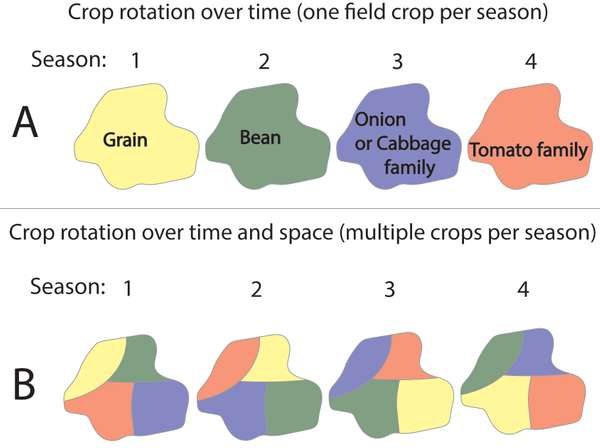
Figure 6. Examples of crop rotations over time (four consecutive seasons/years are illustrated in A) or over space and time (B; colors in B correspond to crop examples in A). Source: Stacy Swartz
Crops in the same family tend to be sensitive to similar pests and diseases. Crop rotation over time and/or space can break the life cycle of a pest by removing the crop host that the pest needs to survive. One option is to rotate a specific field through crops that are sensitive to different pests, over time (Figure 6A). Crops that deter or kill pests can be included in crop rotation schedules; for example, you can rotate crops that are susceptible to nematodes with any number of nematode-suppressing crops (see EDN 75 for some possibilities).
In areas where more than one crop is grown at a time, you can rotate blocks of crops spatially over time (Figure 6B). Switching host crop plants from one location to another will help reduce pest populations over time.
You may want to plant crops with an awareness of when insect pest populations are likely to become a problem. If a particular pest goes dormant for a time (due to cold or dry weather), and you plant ahead of pest emergence, plants can get a head start and gain strength before pests are abundant. However, note that if farmers in your region plant at varying times, some farmers’ crops may experience greater pest pressure because they have planted asynchronously. Be aware of how decisions such as planting time are made at the individual and community levels.
Design to divert or minimize pests (habitat management)
Arguably, the most sustainable ways to prevent pest problems over the long term are linked to habitat management. This approach includes designing systems in ways that either divert pests away from agronomic crops or increase favorable conditions for pests’ natural enemies. Almost all of the methods and techniques around habitat management will increase a system’s overall plant diversity. Gurr et al. (2003) explain how plant diversity helps with pest management while also keeping inputs low. The authors also describe how the benefits of diversity in agricultural systems go beyond pest management.
Conserving native areas around crops can help prevent pests in several ways. Native plants house beneficial insects that prey on pests or outcompete them for resources. Hedgerows around crops can also visually or physically block the entrance of some pests.
Sometimes a farmer plants a trap crop on the outer perimeter of the plot. A trap crop is a preferred host plant for a pest that also affects a primary crop; by planting it around the perimeter, the pest is led away from the field crop to infest the trap crop instead. On some trap crops, pests cannot complete their life cycle, so farmers do not need to manage the trap crop. In other situations, to break a pest insect’s life cycle, farmers harvest and then destroy trap crops, either by feeding the plant material to animals or by burning it.
Farmers can intercrop fields with companion plants. Companion plants benefit crops in several different ways. Some deter pests to which cash crops are susceptible or sensitive. One example is marigold, which can reduce a number of pests in various crops (for more information about marigolds, see EDN 132). Other companion plants attract natural predators of pests.
The “Push-Pull” approach for pest control simultaneously incorporates trap crops and companion plants. The International Centre of Insect Physiology and Ecology and the Kenya Agricultural Research Institute system developed the system, described in EDN 116.
Conclusion
Smallholder farmers in the tropics face increasingly overwhelming hurdles. Population growth, a volatile global climate, and the need for long-term productivity make sustainable food production challenging. Integrated pest management is a platform to equip farmers with diverse decision-making skills. When farmers focus on knowledge and preventative measures, they begin to feel in control of their production, and their mindset about pest management changes from reactionary to preparatory.
References
Chakraborty, S. and A.C. Newton. 2011. Climate change, plant diseases and food security: an overview. Plant Pathology 60:2-14.
FAO. 2017. Fall armyworm spreads to East Africa. FAO in emergencies. Accessed September 9 2019 http://www.fao.org/emergencies/fao-in-action/stories/stories-detail/en/c/882822/
FAOSTAT. (Accessed September 19, 2019). Search terms: Agri-Environmental Indicators, Pesticides (Total), and use per area of cropland. http://www.fao.org/faostat/
Gurr, G.M., S.D. Wratten, and J.M. Luna. 2003. Multi-function agricultural biodiversity: pest management and other benefits. Basic and Applied Ecology 4(2):107-116.
Hahn, S.K., E.R. Terry, and K. Leuschner. 1980. Breeding cassava for resistance to cassava mosaic disease. Euphytica 29(3):673-683.
Kegode, G.O. 2019. Synthetic Pesticides in Africa: the Good, the Bad, and the Ugly. Feed the Future. Accessed September 11 2019 https://www.agrilinks.org/post/synthetic-pesticides-africa-good-bad-and-ugly
Manandhar, A., P. Milindi, and A. Shah. 2018. An Overview of the Post-Harvest Grain Storage Practices of Smallholder Farmers in Developing Countries. Agriculture 8(4):57.
Pagán, I., and F. García-Arenal. 2018. Tolerance to plant pathogens: theory and experimental evidence. International Journal of Molecular Sciences 19(3):810.
Peshin, R., R.S. Bandral, W.J. Zhang, L. Wilson, and A.K. Dhawan. 2009. Integrated Pest Management: A Global Overview of History, Programs and Adoption. In: Integrated Pest Management: Innovation-Development Process; R. Peshin and A.K. Dhawan, Eds. Springer, Dordrecht.
Phung, D.T., D. Connell, G. Miller, S. Rutherford, and C. Chu. 2012. Pesticide regulations and farm worker safety: the need to improve pesticide regulations in Viet Nam. Bulletin of the World Health Organization 90(6):468-473.
Sallam, M.N. 1999. Insect Damage: Damage on Post-harvest. FAO and International Centre of Insect Physiology and Ecology (ICIPE).
Schreinemachers, P, and P. Tipraqsa. 2012. Agricultural pesticides and land use intensification in high, middle and low income countries. Food Policy 37(6):616-626.
Sharma, H.C. 1993. Host-plant resistance to insects in sorghum and its role in integrated pest management. Crop Protection 12(1):11-34.
Sisay, B., J. Simiyu, E. Mendesil, P. Likhayo, G. Ayalew, S. Mohamed, S. Subramanian, and T. Tefera. 2019. Fall armyworm, Spodoptera frugiperda infestations in East Africa: assessment of damage and parasitism. Insects 10,195.
Cite as:
Swartz, S. 2019. Pest Prevention. ECHO Development Notes no. 145